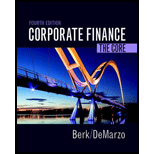
Corporate Finance: The Core (4th Edition) (Berk, DeMarzo & Harford, The Corporate Finance Series)
4th Edition
ISBN: 9780134202648
Author: Jonathan Berk, Peter DeMarzo
Publisher: PEARSON
expand_more
expand_more
format_list_bulleted
Concept explainers
Question
Chapter 23, Problem 18P
a.
Summary Introduction
To determine: The money raised by MP Incorporation.
Introduction: When a company sells its share publically in an open market for the first time, it is known as initial public offering (IPO).
b.
Summary Introduction
To determine: The money received by the venture capitalist.
Expert Solution & Answer
Want to see the full answer?
Check out a sample textbook solution
Students have asked these similar questions
Which of the following is not an investment grade credit rating?*
BB+
BBB+
BBB
BBB-
Company A has a capital structure of $80M debt and $20M equity. This year, the company reported a net income of $17M. What is Company A's return on equity?*
117.6%
21.3%
85.0%
28.3%
12. Which of the following is the formula to calculate cost of capital?*
Total assets/Net debt x Cost of debt + Total assets/Equity x Cost of equity
Net debt/Equity x Cost of debt + Equity/Net debt x Cost of equity
Net debt x Cost of debt + Equity x Cost of equity
Net debt/Total assets x Cost of debt + Equity/Total assets x Cost of equity .
Chapter 23 Solutions
Corporate Finance: The Core (4th Edition) (Berk, DeMarzo & Harford, The Corporate Finance Series)
Ch. 23.1 - Prob. 1CCCh. 23.1 - Prob. 2CCCh. 23.2 - Prob. 1CCCh. 23.2 - Prob. 2CCCh. 23.3 - List and discuss four characteristics about IPOs...Ch. 23.3 - Prob. 2CCCh. 23.4 - Prob. 1CCCh. 23.4 - What is the average stock price reaction to an...Ch. 23 - Prob. 1PCh. 23 - What are the advantages and the disadvantages to a...
Ch. 23 - Prob. 3PCh. 23 - Suppose venture capital firm GSB partners raised...Ch. 23 - Prob. 5PCh. 23 - Prob. 6PCh. 23 - Prob. 7PCh. 23 - Prob. 8PCh. 23 - Prob. 9PCh. 23 - Prob. 10PCh. 23 - Prob. 11PCh. 23 - Prob. 12PCh. 23 - What is IPO underpricing? If you decide to try to...Ch. 23 - Prob. 14PCh. 23 - Prob. 15PCh. 23 - Prob. 16PCh. 23 - Prob. 17PCh. 23 - Prob. 18PCh. 23 - Prob. 19PCh. 23 - Prob. 20P
Knowledge Booster
Learn more about
Need a deep-dive on the concept behind this application? Look no further. Learn more about this topic, finance and related others by exploring similar questions and additional content below.Similar questions
- no ai .What is the enterprise value of a business?* The market value of equity of the business The book value of equity of the business The entire value of the business without giving consideration to its capital structure The entire value of the business considering its capital structurearrow_forward10. The concept of time value of money is that* The cash flows that occur earlier are more valuable than cash flows that occur later The cash flows that occur earlier are less valuable than cash flows that occur later The longer the time cash flows are invested, the more valuable they are in the future The future value of cash flows are always higher than the present value of the cash flows .arrow_forward9. Which of the following is true when a bond is trading at a discount?* Coupon Rate > Current Yield > Yield to Maturity Coupon Rate < Current Yield < Yield to Maturity Coupon Rate = Current Yield = Yield to Maturity Coupon Rate < Current Yield = Yield to Maturity.arrow_forward
- When the price of a bond is above the face value, the bond is said to be* Trading at par Trading at a premium Trading at a discount Trading below pararrow_forward7. What is a par value of a bond?* The amount borrowed by the issuer of the bond and returned to the investors when the bond matures The overall return earned by the bond investor when the bond matures The difference between the amount borrowed by the issuer of bond and the amount returned to investors at maturity The size of the coupon investors receive on an annual basisarrow_forwardWhat is an annuity?* An investment that has no definite end and a stream of cash payments that continues forever A stream of cash flows that start one year from today and continue while growing by a constant growth rate A series of equal payments at equal time periods and guaranteed for a fixed number of years A series of unequal payments at equal time periods which are guaranteed for a fixed number of yearsarrow_forward
- If you were able to earn interest at 3% and you started with $100, how much would you have after 3 years?* $91.51 $109.27 $291.26 $103.00arrow_forwardNo AI 2. The formula for calculating future value (FV) is* FV = PV/(1+r)^n FV = PV/(1+r)*n FV = PV x (1+r)^n FV = PV x (1+r)*narrow_forwardDividend??? solnarrow_forward
arrow_back_ios
SEE MORE QUESTIONS
arrow_forward_ios
Recommended textbooks for you
 Intermediate Accounting: Reporting And AnalysisAccountingISBN:9781337788281Author:James M. Wahlen, Jefferson P. Jones, Donald PagachPublisher:Cengage LearningPrinciples of Accounting Volume 1AccountingISBN:9781947172685Author:OpenStaxPublisher:OpenStax College
Intermediate Accounting: Reporting And AnalysisAccountingISBN:9781337788281Author:James M. Wahlen, Jefferson P. Jones, Donald PagachPublisher:Cengage LearningPrinciples of Accounting Volume 1AccountingISBN:9781947172685Author:OpenStaxPublisher:OpenStax College

Intermediate Accounting: Reporting And Analysis
Accounting
ISBN:9781337788281
Author:James M. Wahlen, Jefferson P. Jones, Donald Pagach
Publisher:Cengage Learning

Principles of Accounting Volume 1
Accounting
ISBN:9781947172685
Author:OpenStax
Publisher:OpenStax College